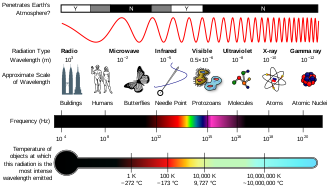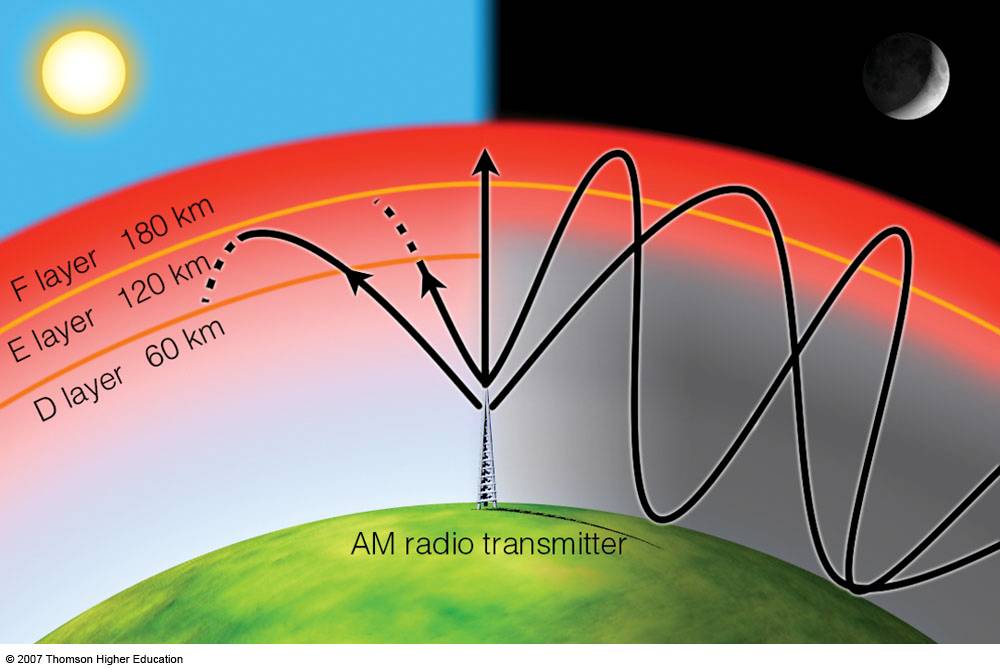
Okay, so say you live in the middle of nowhere. Well, technically, you'd be living somewhere, but that's not the point. So, if you live in the middle of nowhere, would you still have electric lights and be able to watch television and play on the computer? Thanks to that searing hot yellow orb in the sky, the answer is...no. Yeah, just kidding, the answer is really yes. So how do you get the solar energy? You use solar panels! Yay! Solar panels capture the suns rays, which is energy, and turn it into electricity. Didja (pronounced did-jya) know that the sun is really a witch? Ooooh....
So how does the energy from that brilliant sun reach us mere mortals on Earth? The energy travels in waves, electromagnetic waves to be exact. Most waves need matter, or a medium to move through. Like, waves need water. Those are mechanical waves. But electromagnetic waves don't need matter to move through, so they can move through empty space. That's why waves from the sun are different: they don't need a medium to move through. Electromagnetic waves spread out in all directions from the source. Energy that's carried by an electromagnetic waves is called radiant energy. That's just a little background information. Now let's go to the ELECTROMAGNETIC SPECTRUM!
What is the electromagnetic spectrum? At first, our teacher gave us a big pad of paper and told us to write what we know. The paper...was mostly blank. But the electromagnetic spectrum is really interesting. It has to do with a lot of different waves that are really cool and some of them, we use every day. The electromagnetic spectrum isn't anything in particular: it's just a broad name for a lot of different types of radiation. It's organized by the amount of energy each wave in the spectrum carries. Electromagnetic radiation is also known as radiant energy, which is up there. You may think of radiation like nuclear radiation, or plutonium. Radiation is really any movement of energy...through space.
You can look at a radiation wave as a wave of moving electrical and magnetic fields, or you can look at it as protons, which is a river of particles. Electromagnetic waves can't always make up their minds: sometimes they're waves, sometimes particles.


Now, there are some properties of electromagnetic radiation that all of the waves have:
- It can, of course, travel through empty space, where there's absolutely no matter. But we already knew that.
- The speed of light is constant in space, so all forms of light travel at 299, 800 kilometers in space per second. The frequency and wavelength of the wave are connected because of the speed of light.
- Electromagnetic waves are split up into different categories based on their frequency.
Now let's get to the actual electromagnetic spectrum. From least to greatest:
- Radio Waves: radio waves are a low frequency and low energy electromagnetic wave. It has a wavelength that's longer than around thirty centimeters. Actually, believe it or not, some radio waves have wavelengths that can be as long as a kilometer or more. Radio waves are usually used for communication, and the wavelengths are long enough to move around a lot of objects, but, luckily, the energy is too low to be harmful. Here on this dying planet, radio waves are usually created by the electric charge running through an antenna. However, the sun and other objects in space also make radio waves, such as stars. With radios, there's AM radio and FM radio. Am radio uses low energy waves, and FM radio used medium energy waves, but TV uses high energy waves. But radios are dying...now people are using YouTube and Pandora Radio and things like that. Aww.... :(
- Microwaves: microwaves are actually a type of radio wave. It's the same: it's low frequency and low energy. It has a wavelength of about one to thirty centimeters. Like radio waves, microwaves are also used for communication purposes, like cell phones, for all you obsessed people out there. Because microwaves have a shorter wavelength than radio waves, microwaves are usually less scattered around by particles in the air. Microwaves are obviously also used to heat up food...it's quite interesting to know how it heats up food. This is because of the frequency range of the microwaves...food molecules like water absorb the energy, causing it to heat up. Microwaves are useful for satellite communications, mostly because they can pass through Earth's atmosphere. Microwaves are also used in airplane radar systems. Bet you didn't know that. You probably thought it only had to do with the microwave you heat up with. If you did, don't worry; I thought that, too.
- Infrared Wave- this wave has a shorter wavelength than a microwave, but it's longer than light. Vibrating molecules in any type of matter produce infrared waves. Actually, even your body emits it. You can't see infrared wave, but if you've ever warmed your hands on a heater or near a fire, you can definitely feel them. Your skin senses infrared with a longer wavelength as heat or warmth. But infrared rays that have a short wavelength don't feel warm. I think, though, that all of us have watched television at some point. If you have, and you've used a remote control, the clicker (what I call the remote control) sends out the infrared waves to the television. It also sends out infrared waves to your stereo and DVD player. It can also be used to take special types of pictures called thermographs.


- Visible Light Waves: this is the wave that your eyes can see, obviously. We think of colors as red, orange, yellow, green, blue, indigo, violet. Actually, that's organized into the lowest to highest energy: the colors of the rainbow. The reason we see wavelengths as color is because of type of cell called cones. Red light has the longest wavelength but the lowest frequency. Violet has the shortest wavelength and the highest frequency. They each represent a whole family of colors (bet they fight a lot), and all of them have a varying range of wavelengths. Did you ever know light was that complicated?
- Ultraviolet Wave: has a shorter wavelength and higher frequency than light. Ultraviolet waves carry enough energy to cause a chemical reaction and they occur naturally from sunlight. A lot of ultraviolet rays come from the sun, but Earth's atmosphere (the ozone layer, which is why we need to take care of it!) stop most of the rays from reaching us tiny people down on Earth. ultraviolet rays also cause the aurora borealis, or the Northern lights, by shining through carbon dioxide in the atmosphere. Most people think that when it's cloudy, you can't get a sunburn. But you're wrong! Ultraviolet waves are strong enough and carry enough energy to penetrate and travel through clouds and go into skin. They can kill or damage cells, which causes sunburn, skin cancer, and cataracts. So, yeah, protect the ozone layer! It's way more important than you think.
- X-rays: has a shorter wavelength and a higher frequency than a ultraviolet waves. They have a very high penetrating power. They can easily travel through almost anything. Doctors use a little bit of the x-rays to take pictures of your bones, because it's not as easy for the x-ray to travel through the bone than it is for it to travel through skin and muscle. The calcium in the bone stop the x-rays, actually. Scientists study blacks holes and star explosions by examining the x-rays they give off. Cool, huh?
- Gamma ray: this electromagnetic wave is the most energetic in the electromagnetic spectrum. It's a high-energy electromagnetic wave that has a shorter wavelength and a higher frequency than all the other types of electromagnetic waves. A lot of gamma rays come from outer space, and they are absorbed by our atmosphere. All matter is made up of atoms, and all atoms are made up from neutrons, protons, and electrons. So when the nucleus of an atom breaks apart or changes, or if it drops from one energy to another, electromagnetic radiation occurs. They're also produced in high-energy Earth explosions, like nuclear explosions. They do a lot of damage when they pass through living cells, which is why physicians use them to try and destroy cancerous cells. Gamma rays form in space during violent events, such as an explosion of a star, like x-rays. But radiation is bad. Trust me. That is not the way you want to die.

The sources of the electromagnetic spectrum are accelerating electric charges. An example is the generation of radio waves by the electric charges in an antenna. Electromagnetic waves are made up of electric fields, which is kind of like the Earth's gravitational field but deals more with charges and magnetic fields. The electric fields come from a voltage, or a difference between two points in space, like a battery. Magnetic fields come from moving charges, like a current in a circuit. It's the combination and interaction of both fields that are a source.

Now, a difference between microwaves and radio waves are the frequency at which they operate. Microwaves are basically in the ultra-high, super high, and extremely high frequency bands. But microwaves are radio waves. They're both used to transmit information. They're both vibrations in the electromagnetic field. It's only that microwaves have a higher frequency. The term microwave refers to a variety of frequencies in the radio spectrum from three hundred megahertz to three hundred gigahertz.
And the difference between ultraviolet and infrared radiation is simply the wavelength. Infrared waves have a longer wavelength than ultraviolet waves...about one thousand times longer. It doesn't seem like a big difference, but trust me, it is. And that's all, folks. I know it was a bit long, but it's supposed to teach you something, right? Right. I definitely learned something if you didn't, so this wasn't a waste of my time. I hoped you enjoyed reading my blog, aside from the fact that it was a bit long. As always, my classmates' blogs are below, along with some links if you want to learn more. See you next time, I'm peacing out!
Katie's BlogLogan's Blog
A Pretty Good Website
Webstie For Kids
Interactive Site











